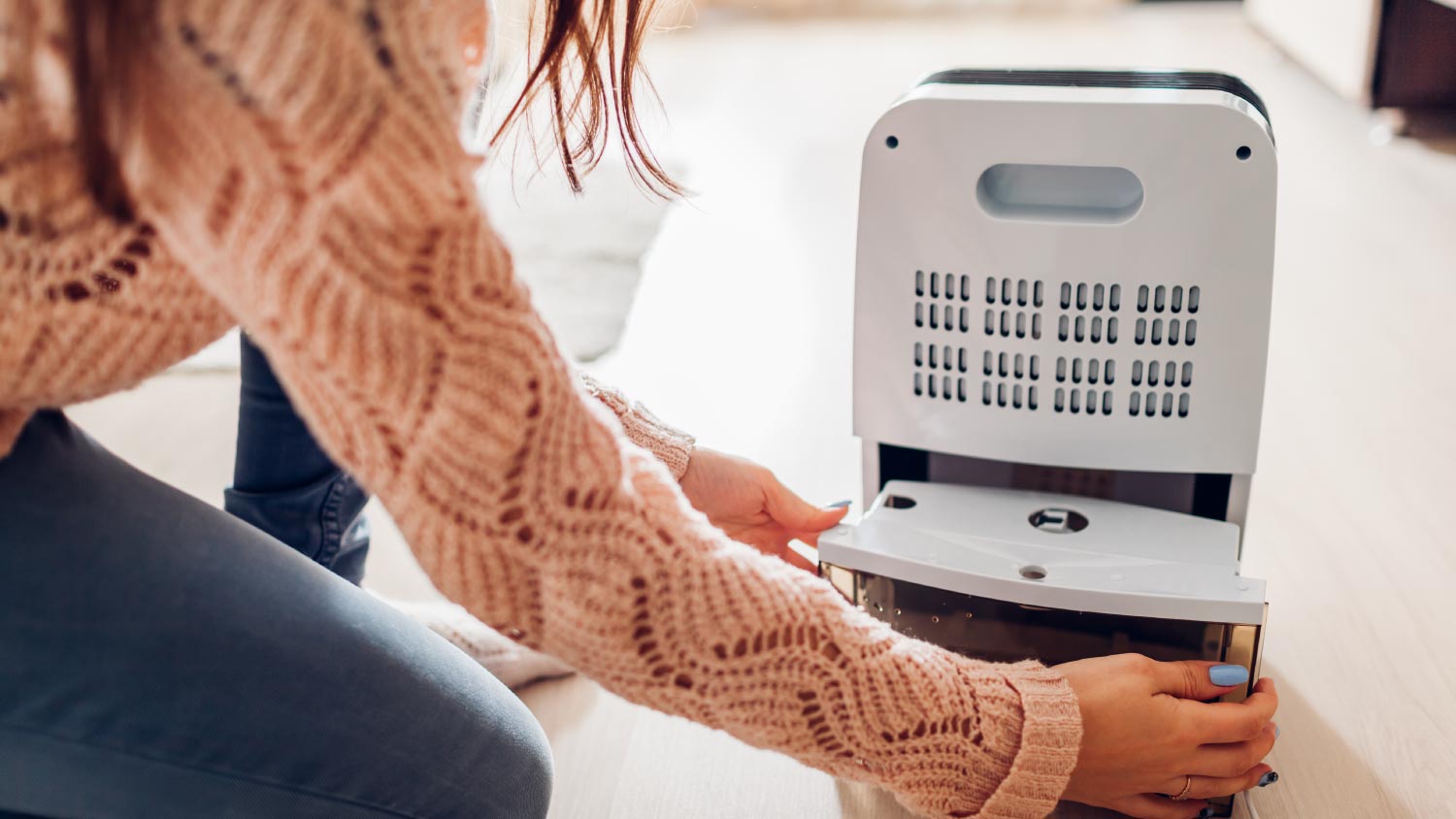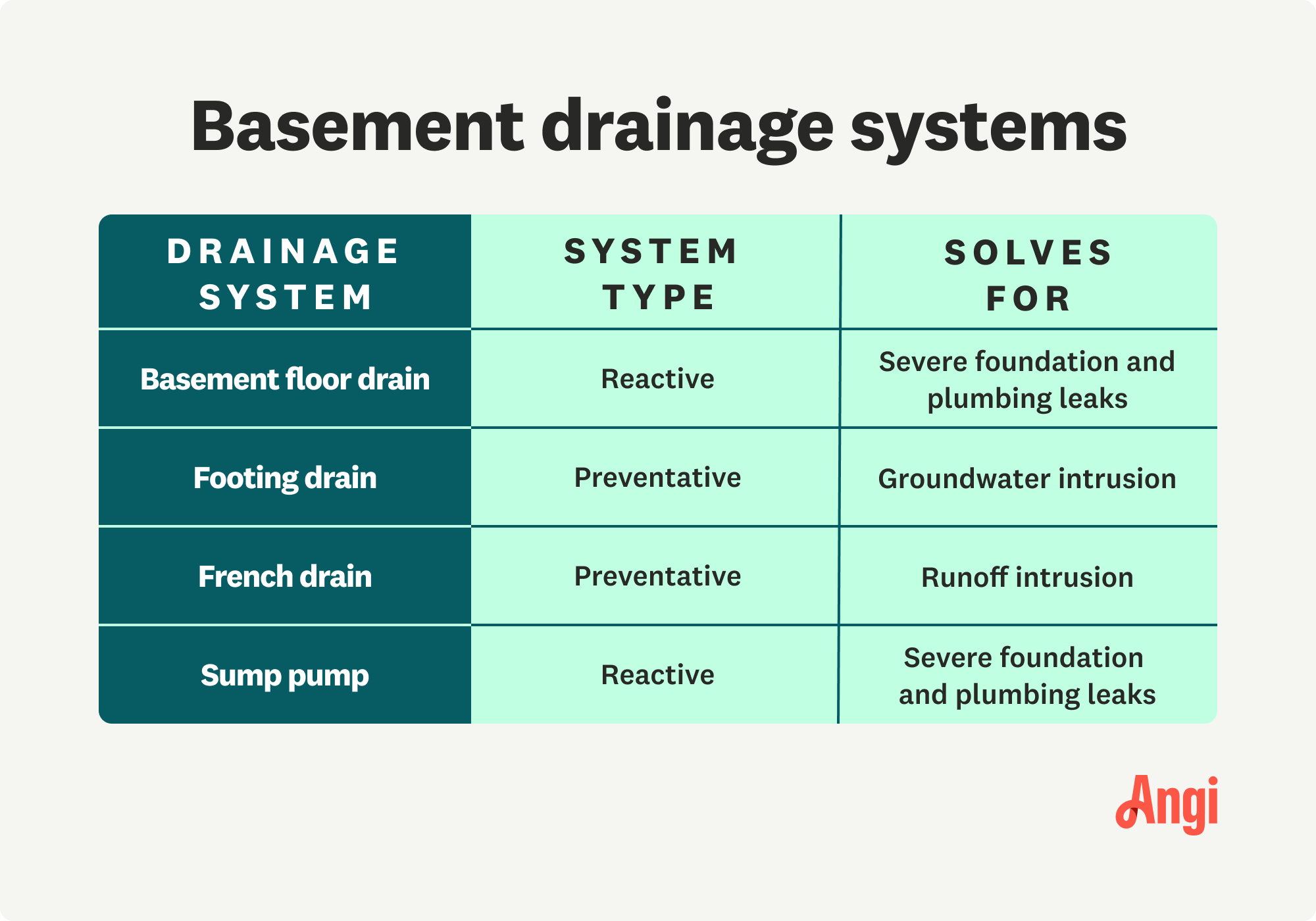How to Keep Your Basement Dry and Get Rid of Moisture
Drying the area and using preventative measures can permanently fix basement moisture


Moisture can cause various types of damage to your basement.
Having a damp basement is common and often due to weather-related events.
Measures you can take to prevent and reduce basement moisture include sealing your walls and using a dehumidifier.
Basements can either be damp, musty, and unwelcoming areas under your home that serve little purpose or serve as additional living spaces that are as clean and inviting as your main living area. The difference often comes down to moisture. Basements naturally trap moisture, but there are plenty of things you can do to get rid of the humidity and keep the space dry. In this guide, we’ll explain why basement moisture is an issue, some underlying causes, and how you can solve the problem once and for all.
Is Moisture in Your Basement a Serious Problem?
Yes, a damp basement can be a serious issue that leads to a whole slew of related problems. Moisture underneath your home can be damaging in the space itself, but it can also travel upstairs through a process called the stack effect, ultimately having a negative impact on your main floors as well. Some of the most common issues that result from basement humidity include:
Mold growth
Pest infestation
Structural damage from wood-destroying insects (WDI)
Poor indoor air quality
Humidity in your living space
Increased utility bills
Damaged insulation and other building materials
Wood rot and potential resulting structural issues
The repairs and remedies for these issues can easily total several thousand dollars, and preventative measures can rise above $10,000 depending on the underlying problem and the extent of the issue.
What Causes a Damp Basement?
Since basements are enclosed, they will naturally trap any moisture that gets in there. Unfortunately, basement moisture can come from a few different places.
Foundation Cracks
All foundations crack, and any crack in the concrete can let water into your underhome area. In most cases, cracks from normal settlement won’t be a major issue. It’s more likely that structural cracks that are ⅛-inch wide or more will be your problem.
When runoff from rain or snow soaks into the soil around your home, it can eventually leak through large cracks and evaporate into the air in your basement.
Contact With Soil
Even if your foundation doesn’t have any cracks, the water in the soil can still wick through the porous concrete if it remains in contact with your foundation for an extended period of time. When this occurs and the water reaches the interior wall, it evaporates into your basement, usually leaving behind white minerals on the wall called efflorescence.
Plumbing Leaks
While exterior water in the soil is more often the culprit for humidity and water damage in your basement, interior plumbing leaks can also cause issues. Even small pinhole leaks in aging and corroded pipes that don’t leave pooling or standing water in your basement can create problems with basement humidity.
Basement Bathrooms or Kitchens
If your basement has a bathroom or a kitchen, the hot water and steam from bathing or cooking can get trapped in the air and eventually cause problems. Installing an exhaust fan in the bathroom and a vent hood over the range can help prevent moisture issues from developing.
At-Home Gyms
Basements are popular areas of the home to set up exercise equipment. But, without a dehumidifier, any sweat you evaporate or moist air you breathe out while exercising can contribute to basement moisture problems.
"Waterproofing is crucial for basements to prevent water intrusion, mold growth, and structural damage. Interior waterproofing methods like sealants and vapor barriers help control moisture levels but don't address the root cause. Exterior waterproofing, such as waterproof coatings and French drainage systems, are often more effective in preventing water from entering the basement."
— Tim O'Shea, The Build Pros
How to Get Rid of Moisture in Your Basement
Since basement moisture is such a prevalent and potentially expensive issue, it’s important to take the steps necessary to eliminate it and prevent problems in the future. Luckily, there are things you can do to keep your basement adequately protected.
1. Seal and Waterproof Your Basement
Sealing your walls and floor can help you get ahead of potential leaks, as these are the most likely culprits for allowing water into your basement. Waterproofing your basement can either involve putting a vapor barrier over the concrete or applying a waterproof paint to the concrete. It’s important to note that this isn’t a standalone solution and is just one step in your overall basement waterproofing efforts.
You should also seal foundation cracks where water and water vapor may be entering. If you have cracks that are level from side to side and are less than ⅛-inch thick, you can probably safely seal them yourself using a concrete crack sealer. For more severe cracks, you may need a structural engineer to confirm that you don’t have structural issues. After that’s confirmed, we recommend hiring a basement waterproofing company near you to seal the wider cracks.
2. Try a Dehumidifier

Basements tend to be more humid than other parts of the house, so even if moisture isn’t a problem in your main living area, you can benefit from installing a dehumidifier in your basement. We recommend installing a self-draining dehumidifier that drains into your sump pump, as you won’t need to remember to empty the tank manually when it gets full.
You can go for a smaller, portable unit, but if you really want to make a big impact, you can invest in a permanent basement dehumidifier. These range in cost from $800 to $1,200 for a 75-pint model to $1,700 to $2,000 for a 130-pint model. In most cases, they are well worth the investment to prevent humidity from building up.
3. Insulate Pipes and Walls
On hot and humid days, in particular, damp air in your basement can condense on the surface of plumbing pipes, drip onto building materials, and cause water damage in addition to ongoing humidity problems. Insulating your pipes can help to reduce this condensation. Plus, in extremely cold climates, insulating your basement walls can save energy and reduce your heating costs.
You can also add insulation behind the walls in your finished basement or to the underside of the flooring system above. Insulation helps to make your home more energy-efficient, and can also act as another barrier to keep moisture outside where it belongs. Be careful to use insulation that won’t hold moisture and promote mold growth. Spray foam and rigid foam insulation are good options; batt insulation doesn’t provide a barrier for moisture and, therefore, isn’t a great option for a basement.
4. Make Sure Your Gutters Work Properly
If you don’t have a gutter system installed on your property, having a professional install gutters, downspouts, and downspout extenders is a highly effective way to keep moisture out of your basement.
Since most issues with damp basements come from runoff in the soil working its way inside, gutters, which relocate excess runoff away from your foundation, are a great way to avoid moisture problems.
Just keep in mind that, over time, debris like leaves, sticks, and acorns can accumulate in your gutters, resulting in blockages. The consequence of clogged gutters is often water spilling over the sides and landing right against the foundation. Regularly inspecting and cleaning the downspouts and gutters can help successfully direct water flow away from your home’s foundation.
5. Install a Foundation Drainage System
Foundation drainage systems are also highly effective for reducing the amount of groundwater that comes in contact with your basement walls and seeps inside, creating moisture problems.
There are a few different kinds of systems that can help solve underlying foundation drainage problems. Preventative drainage systems are better for keeping moisture at bay, while reactive systems help avoid standing water that also contributes to a damp basement.

6. Exterior Waterproofing
Exterior waterproofing, also called damp-proofing, is either a rubber barrier or waterproof paint that you can use on the exterior wall of your foundation. The barrier prevents water in the soil from coming into contact with your foundation, which can limit leaks through foundation cracks as well as water wicking in through the pores in the concrete and evaporating inside. The paint can help limit how much water wicks through the concrete.
It’s best to waterproof your basement’s exterior walls during construction to keep costs down. Waterproofing efforts on the inside of your home are more affordable, given the ease of access.
7. Soil Gradation
Grading soil away from your home at a slope of one inch per foot for every 5-to-10 feet away from your foundation is one of the simplest ways to prevent a damp basement. Graded soil creates a natural downward slope that will pull excess runoff away from your foundation. This often isn’t a standalone solution, but in combination with a gutter system and other methods, it could be enough to keep your basement dry.
DIY vs. Hiring a Pro to Fix a Wet Basement
Many of the strategies for fixing a damp basement are suitable for DIYers, but others require the help of a professional. Some of the things we recommend for DIYers include:
Grading the soil away from your foundation.
Cleaning out your gutters and downspouts.
Installing downspout extenders.
Carrying out a DIY inspection two to four times per year.
Installing a portable dehumidifier.
Sealing non-structural hairline cracks in the foundation.
The more involved—and often more permanent—solutions to a damp basement are best left to professionals who can handle the scope of work. Some things best left to the pros include:
Installing gutters and downspouts.
Carrying out professional inspections.
Stabilizing and sealing wide or structural cracks.
Installing a built-in or permanent dehumidifier.
Insulating pipes and walls.
Installing a foundation drainage system.
Installing exterior basement waterproofing.
Frequently Asked Questions
In many cases, yes, a damp basement can be bad for your health. Not only can damp air affect your lungs, but it can promote mold growth and pest infestation. Mold spores can be dangerous to breathe in, as can waste particles from insects and rodents attracted to the moisture. Damp, moldy air can also move up into your living area. As such, it’s crucial to fix any basement moisture problems as soon as they crop up.
While it’s possible to live in a damp basement, it’s usually not healthy to do so. Damp air affects your breathing, and it also promotes mold growth and pest infestation that can make living in a damp basement dangerous. You should plan to resolve any moisture issues and set up preventative measures before using your basement as a living space.
Yes, the air from a damp basement can travel up into your living area through a process called the stack effect, so moisture, mold spores, and other debris in your basement air can all decrease your indoor air quality on your main floors. Additionally, damp basements can promote the rotting of building materials, which can damage flooring, insulation, and framing on your first floor in addition to materials in the basement.





- 7 Reasons Water Is Seeping Through Your Basement Floor
- How to Waterproof a Basement Like a Pro
- How to Fix a Leaky Basement: 7 Tips
- Basement Foundation Types, Pros, and Cons
- How to Get Rid of Musty Smells in Your Basement for Good: 4 Options and Prevention Methods
- Top Reasons and Solutions for Basement Flooding
- What Is Basement Waterproofing and How Does It Work?
- 8 Tips for a Smooth DIY Basement Remodel, From Drainage to Drywall
- When to Worry About Cracks in Your Basement Floor
- How to Ventilate a Basement: 5 Potential Methods










